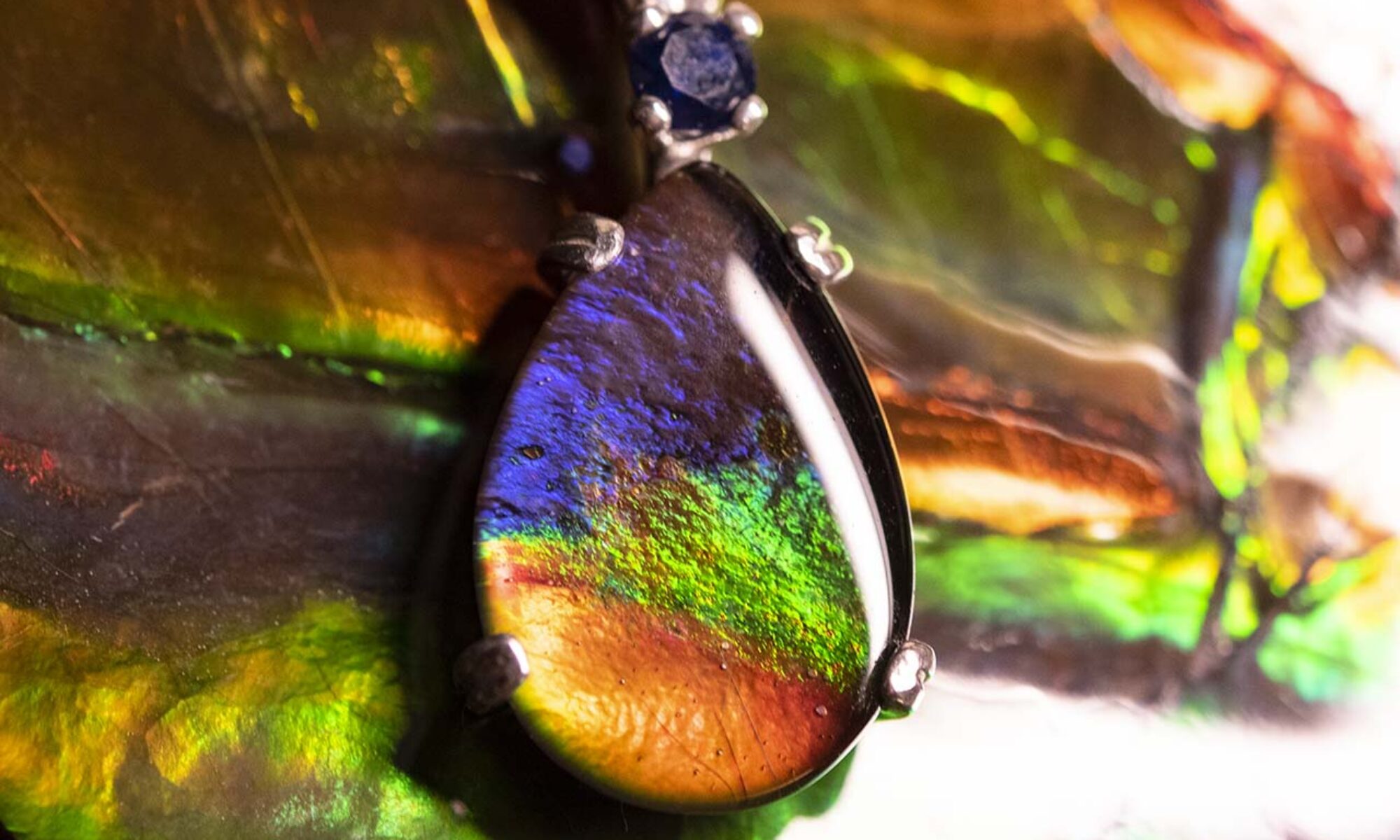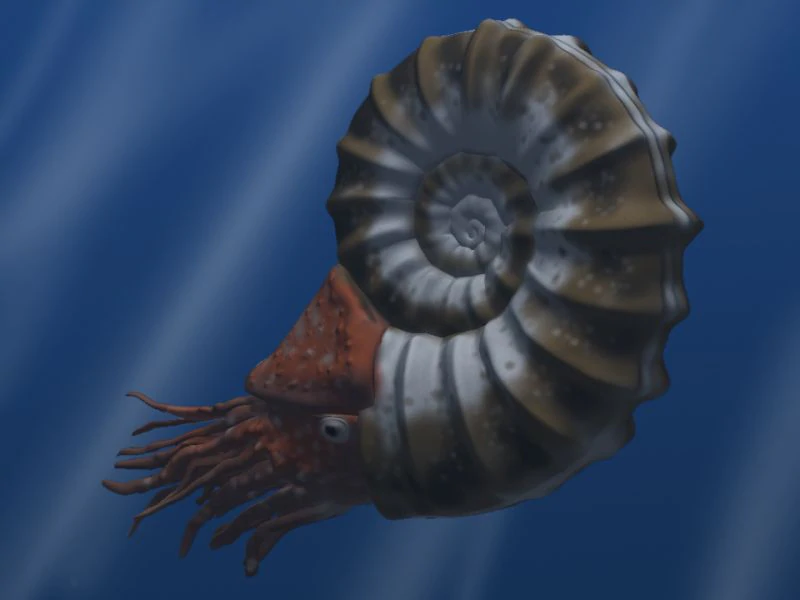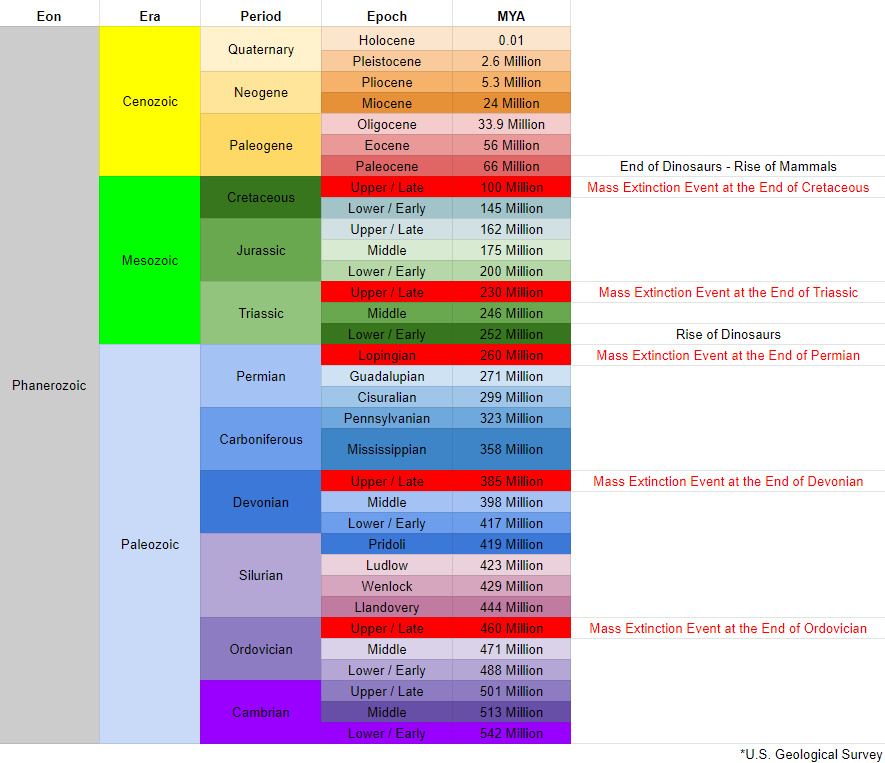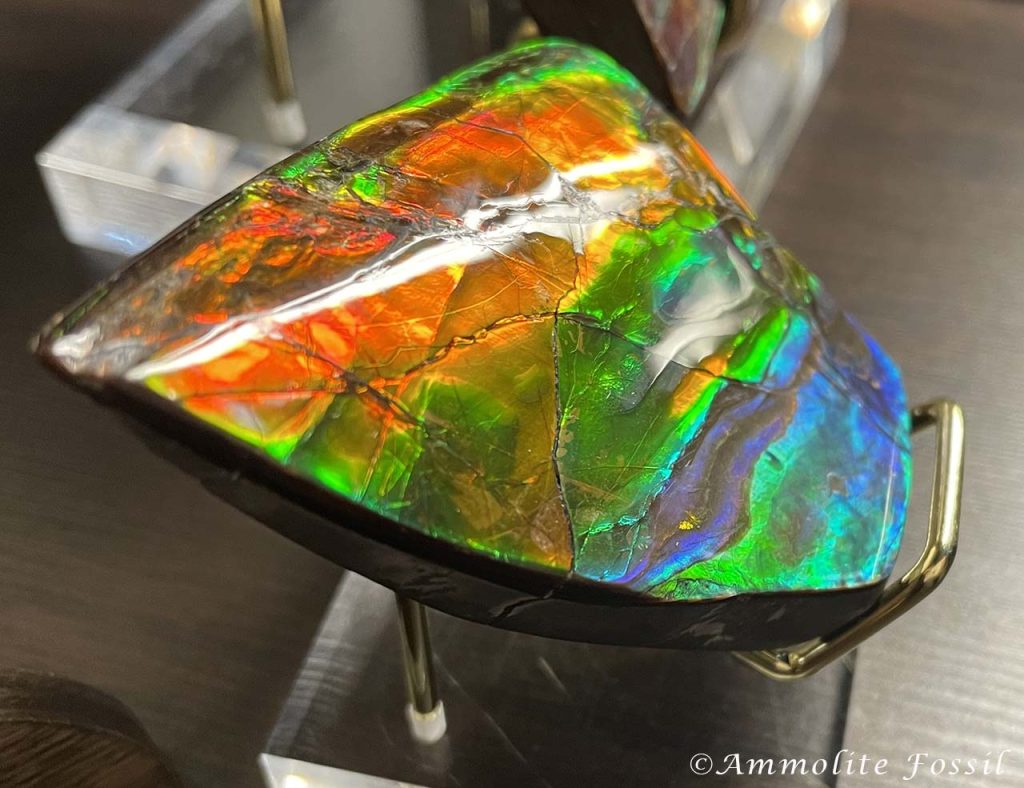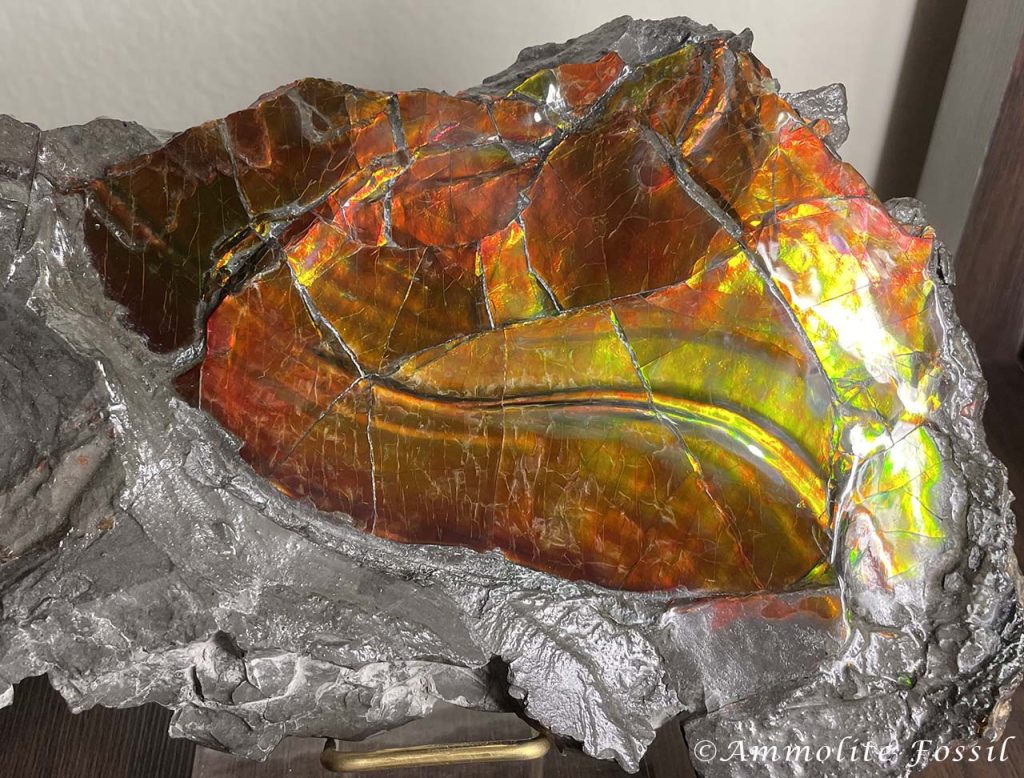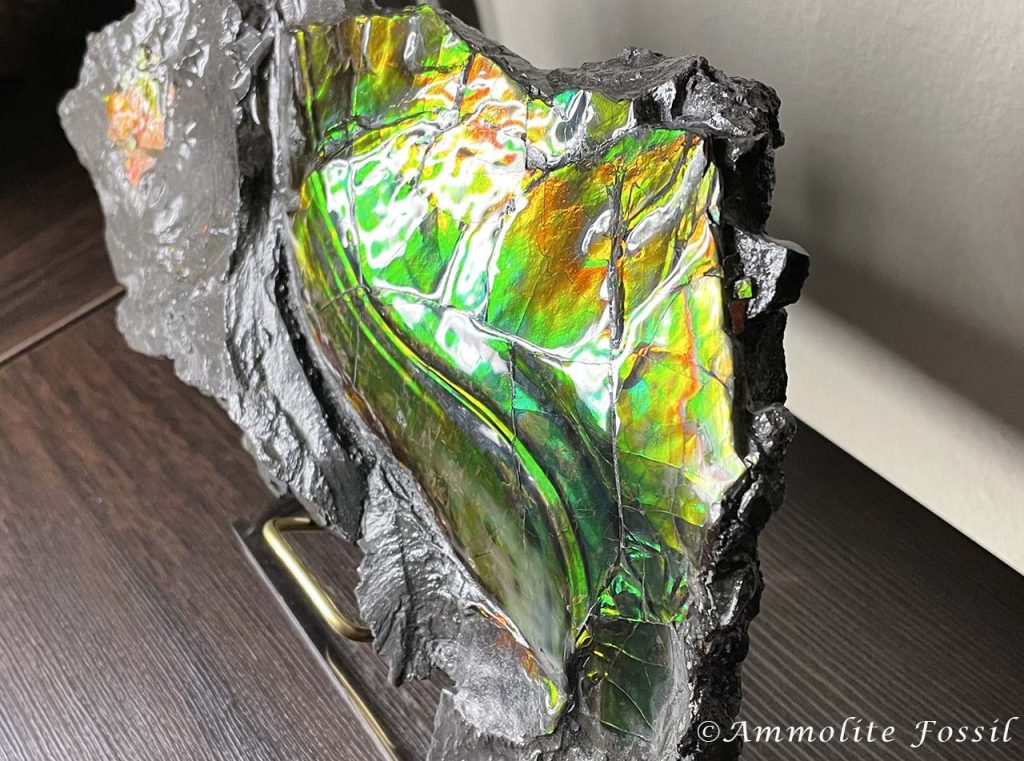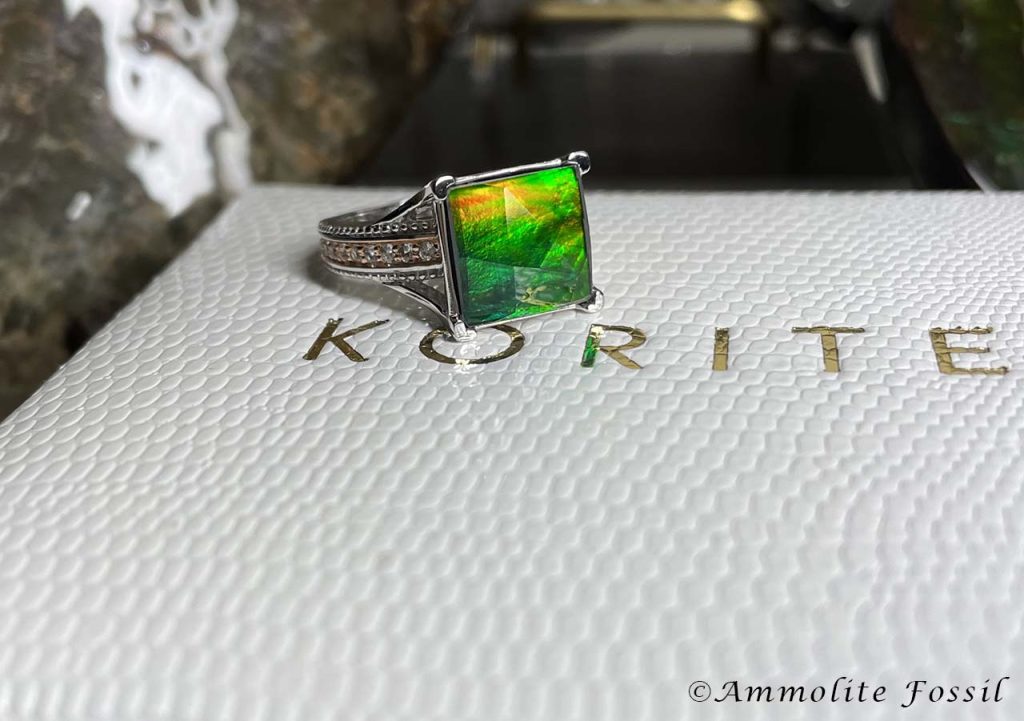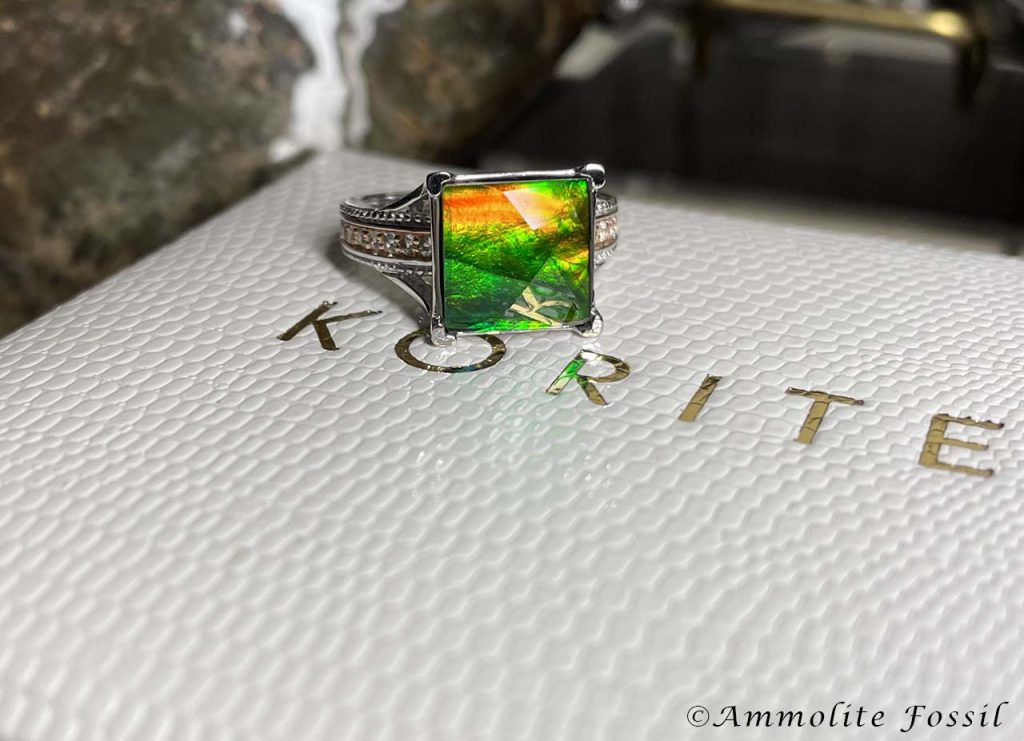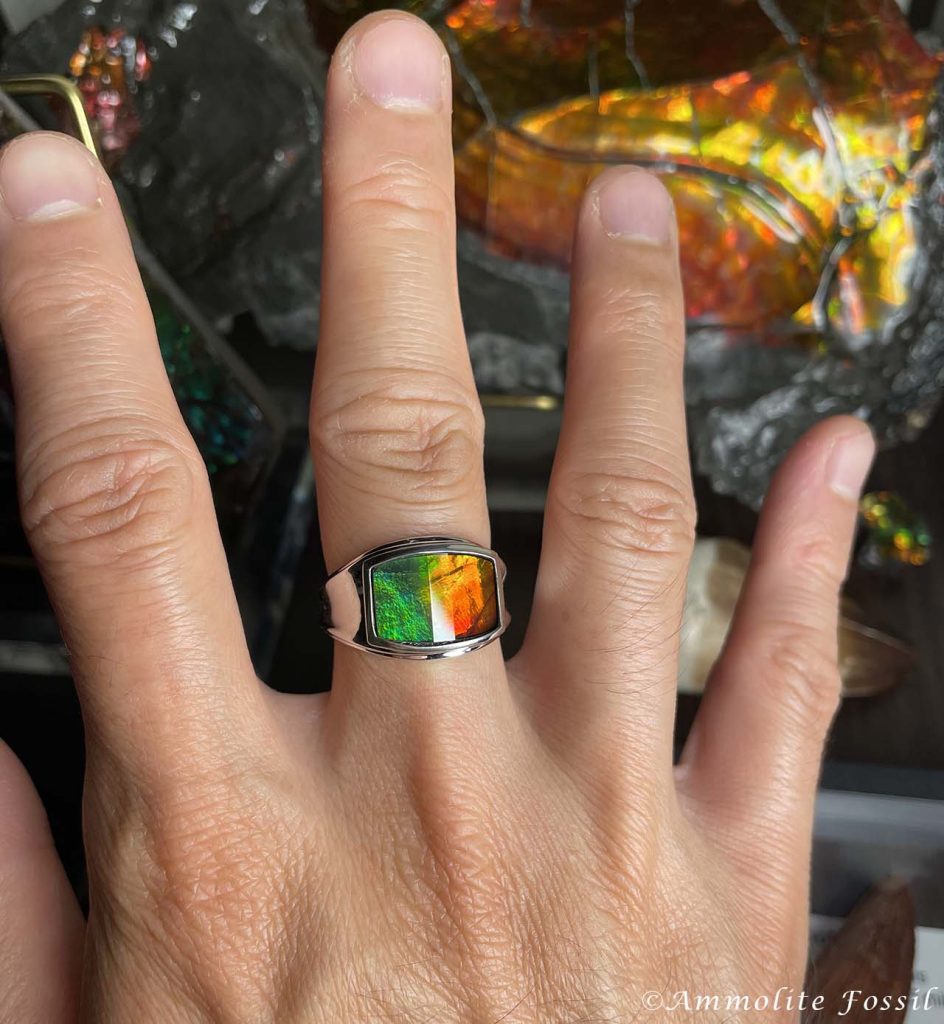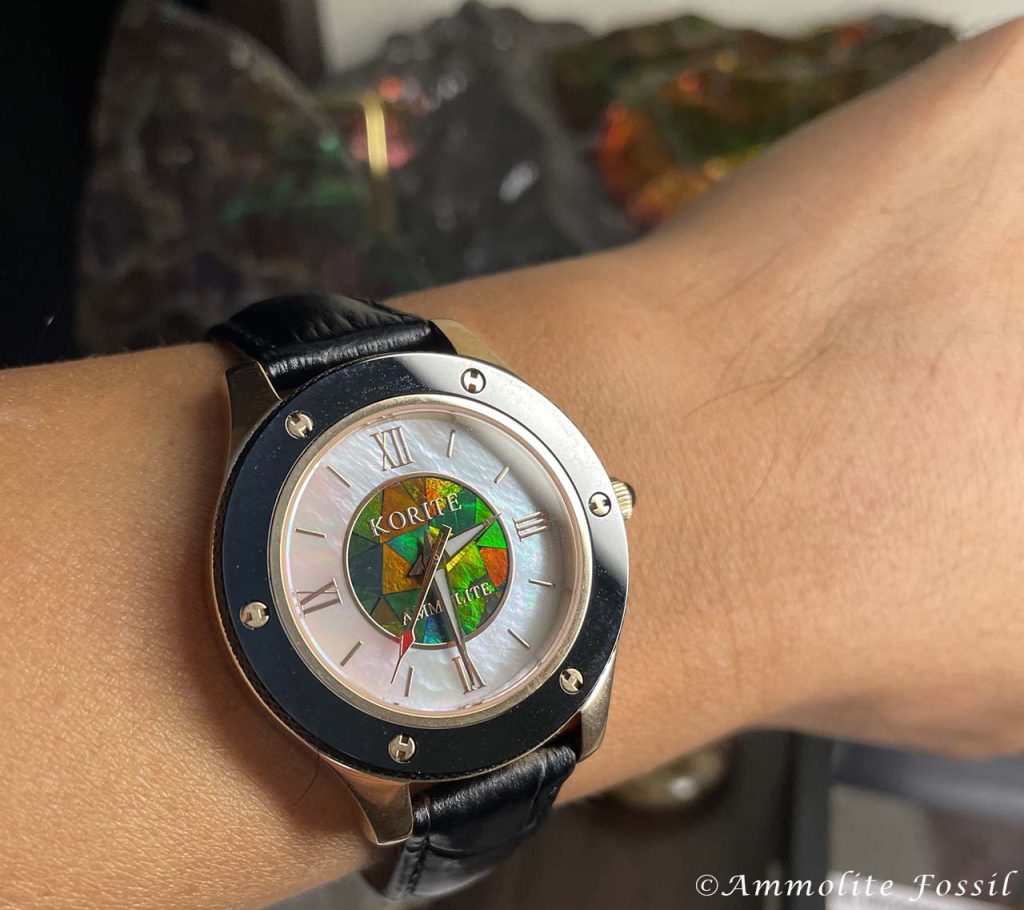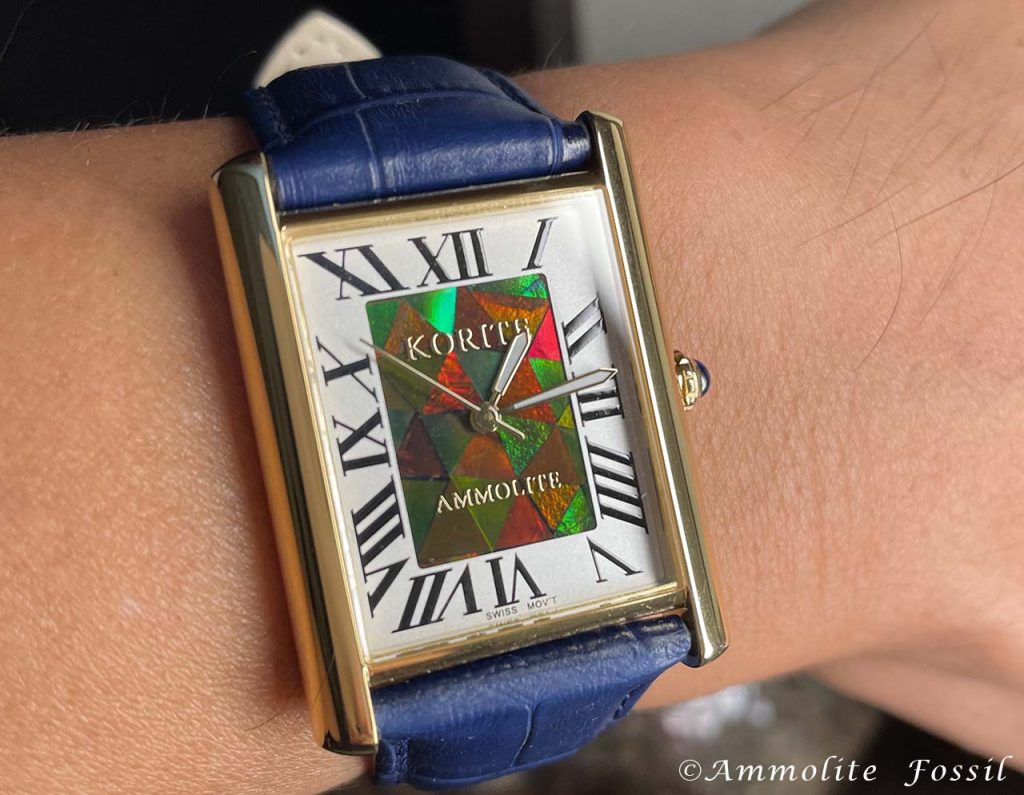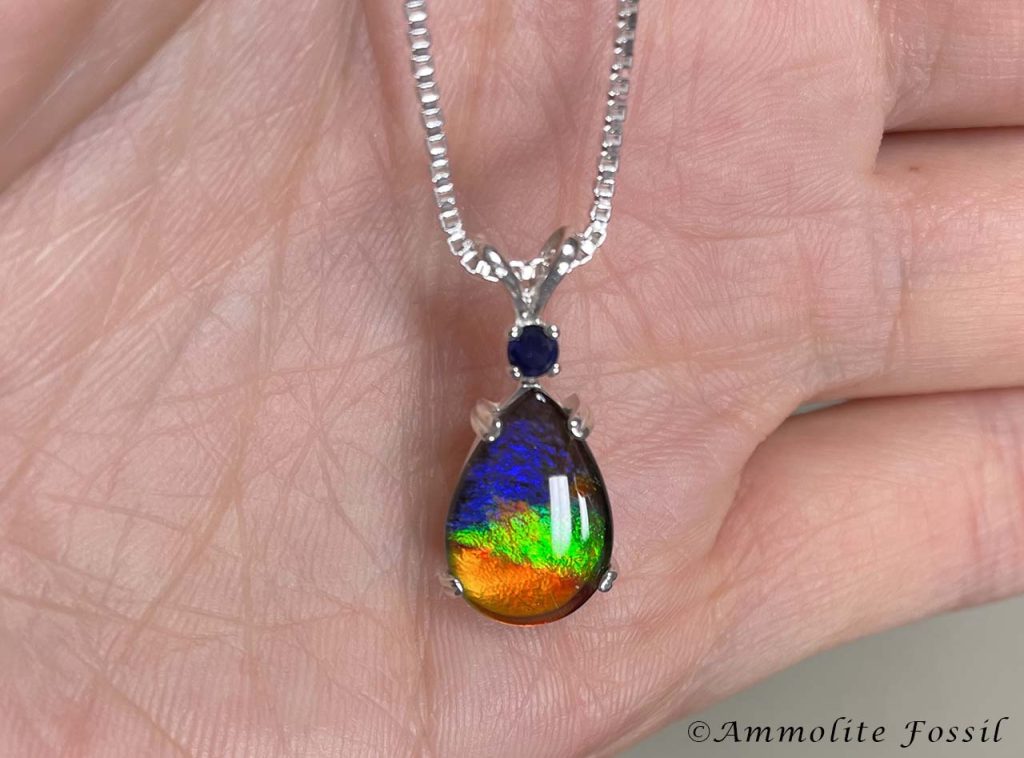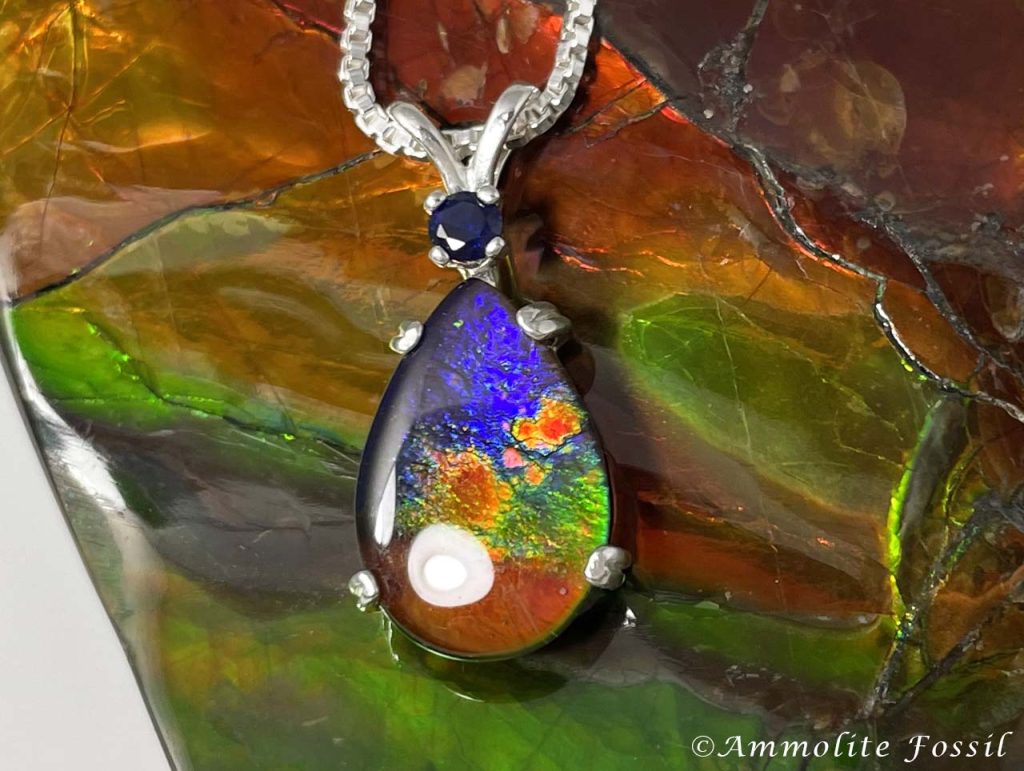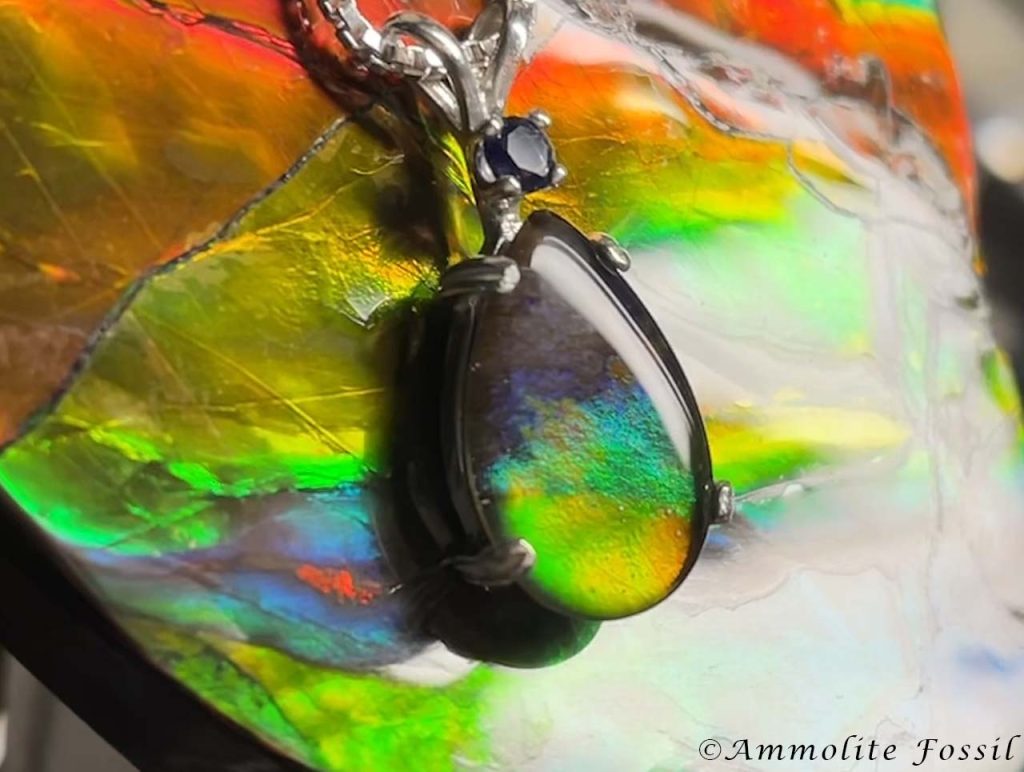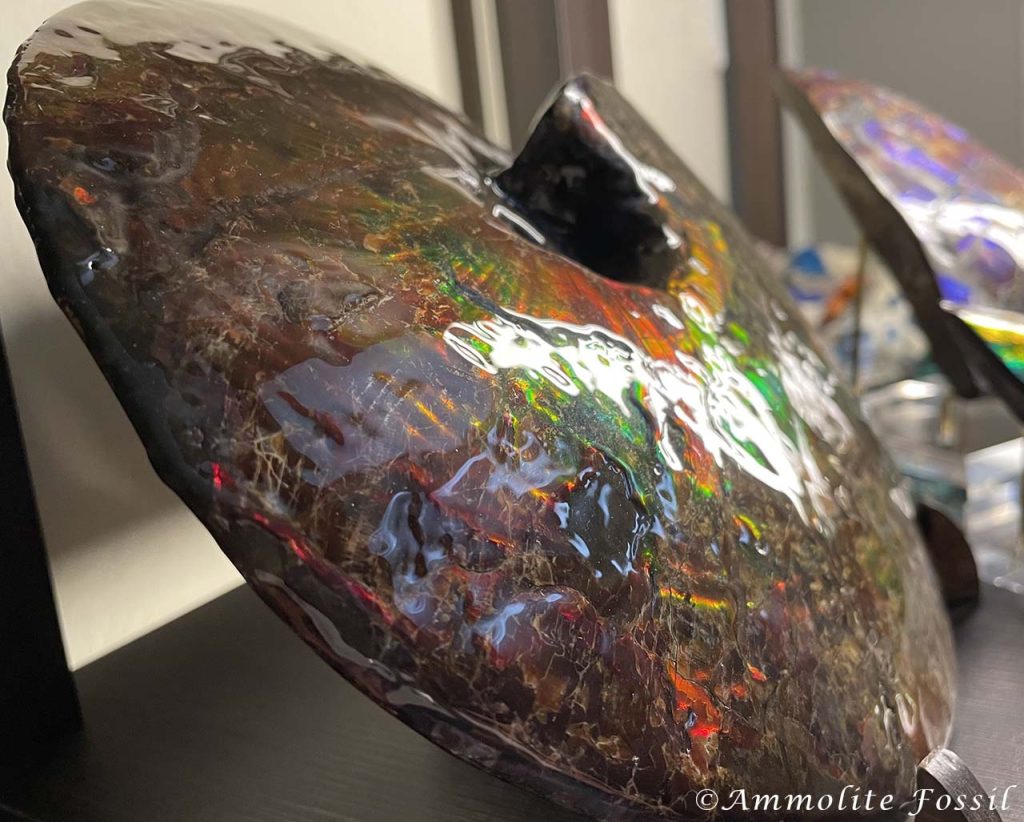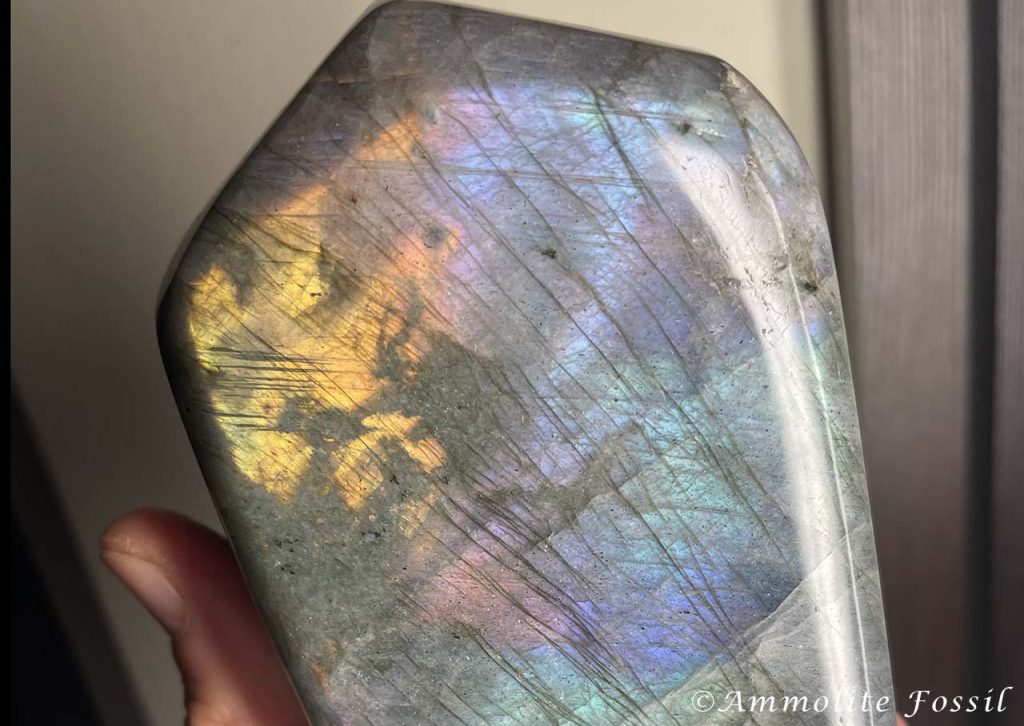Ammolite is a rare iridescent gemstone made from the fossilized shells of ammonites, a type of extinct marine mollusk. It is one of the three biogenic (organic) gemstones in the world, the other two being amber and pearls. The people of the Blackfoot tribe of Alberta and Montana have known about ammolite for many generations. They refer to this gemstone as “iniskim”, meaning “buffalo stone”. Ammolite gemstone is believed to have magical healing powers and positive energy. Ammolite was first recognized as an official gemstone in 1981 by the World Jewellery Confederation (CIBJO). In March 2022, Alberta declared ammolite to be the official gemstone of Alberta province.
Ammolite vs Ammonite
Ammolite gemstone is composed of fossilized shells of ammonites found in Alberta, Canada. Ammonites are extinct prehistoric cephalopods that perished along with the dinosaurs 66 million years ago.
These sea creatures thrived during the Paleozoic and Mesozoic era, surviving three mass extinction events; most notably the mass extinction event at the end of Permian period, where 96% of all marine species perished. Ammonites evolved and hunted the seas until they eventually went extinct during the Cretaceous–Paleogene (K–Pg) extinction event (also known as the Cretaceous–Tertiary (K–T) extinction). This mass extinction event occurred 66 million years ago at the end of the Cretaceous period. It wiped out 3/4 of all animals and plants, including non-avian dinosaurs.
When ammonites died, their shells were buried in sediments under the sea, which eventually became shale. Over millions of years, the shells became fossilized. You can find fossilized ammonites all over the world. Ammonites with iridescence have been found in Utah, Montana, Saskatchewan, England, Russia, and Madagascar. But only in Southern Alberta, Canada, in the Bearpaw Formation along St Mary River, can you find gemstone quality ammolite.
Ammolite Gemstone – The Science
Ammonite shells are composed primarily of aragonite (Calcium Carbonate CaCO3), the same mineral contained in nacre, or mother of pearl. Unlike most other gems, who’s colors come from light refraction, the iridescent color of ammolite comes from light interference that rebounds from stacked layers of aragonite. The thicker the layers, the more reds and greens are seen; the thinner the layers, the more blues, purples, and violets are produced. Reds and greens are more common, while blues and purples are rare. Certain hues, such as crimson, golden yellow, turquoise, and violet are prized by collectors.
Due to the location of this geological region (Bearpaw Formation); through volcanic activities, heat, and mineralization over millions of years, the shells of ammonites were protected in siderite and pyrite concretions. These sediments preserved the aragonite on the shells, preventing it from turning into calcite.
Ammolite’s chemical properties consist primarily of aragonite, but may also contain calcite, silica, pyrite, or other minerals. The shell itself may contain trace elements of aluminum, barium, chromium, copper, iron, magnesium, manganese, silicon, strontium, titanium, and vanadium. Its hardness scores 3.5 – 4.5 on Mohs scale, and its specific gravity is 2.60 – 2.85.
Ammolite Gemstone – Chromatic Shift
Ammolite fossils are prized for their opal-like color play known as chromatic shift. Depending on the viewing angle, colors of the ammolite gemstone will change. Sometimes subtle, sometimes dramatic, standard quality ammolite gemstones will have a dichromatic shift where red changes to green, green changes to blue, etc. Higher quality ammolite gemstones will display spectro-chromatic shift, where colors shift through an entire color spectrum. Some gemstones however, will only display color shifts from the same family, such as different hues of red. This is called monochromatic shift. The color play of ammolite gemstone is truly mesmerizing.
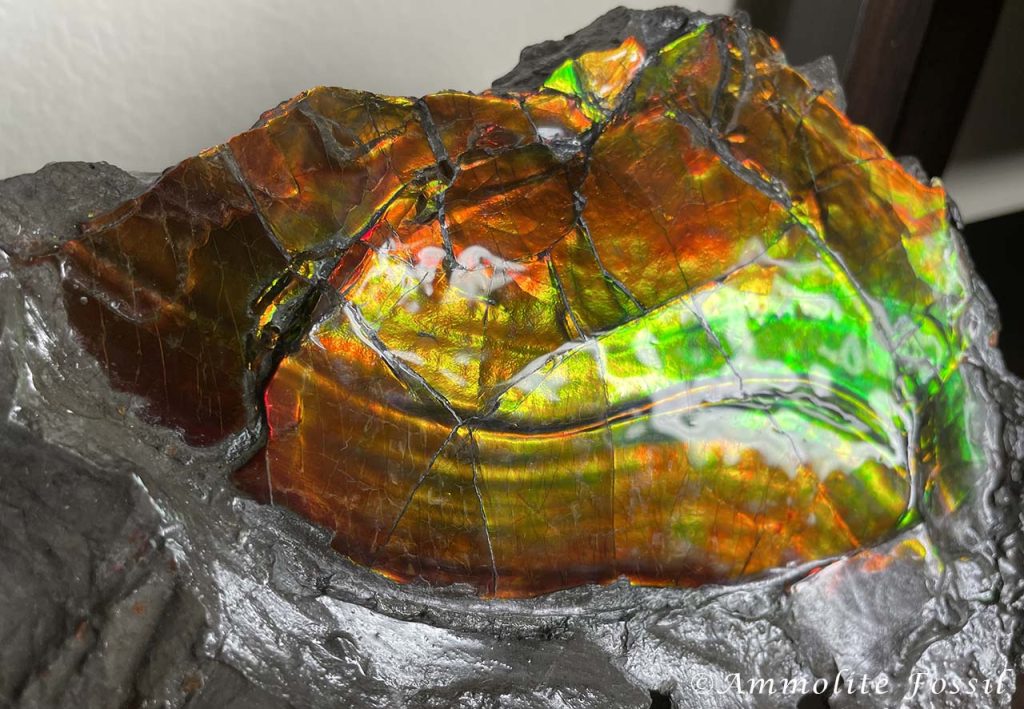
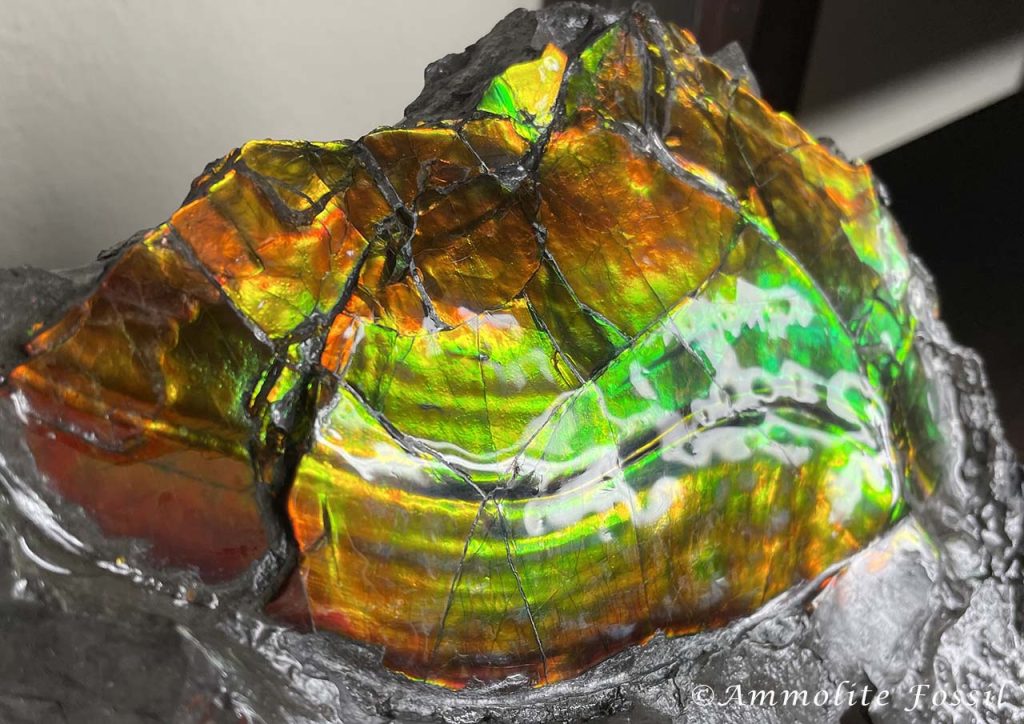
Ammolite Gemstone Jewelry
Ammolite gemstones make for exotic and eye-catching jewelry, no two are alike. Ammolite jewelry has become popular in the United States, Japan, and China. However due to its rarity, you are likely the only one in your circle to be wearing this fashionable jewelry. It is often the perfect conversation starter. If you are looking to stand out in the crowd and set yourself apart from everyone else, then ammolite jewelry is for you.
Ammolite gemstones are usually fashioned into ammolite naturals, doublets, and triplets.
Doublets – Due to the thin aragonite layer that gives ammolite gemstones the beautiful color play, ammolite often has to be stabilized with epoxy resin and backing. This is known as a doublet, as it contains two layers; the ammolite, and backing using either the original shale or other materials. The first commercial doublet was introduced in 1967. These doublets can be fashioned into rings, earrings, and pendants.
Triplets – Much like doublets, triplets add an additional layer of calibrated cap on the top of ammolite gemstones. The material used is usually quartz or spinel. Since ammolite is a rather soft gemstone (Mohs scale 3.5 – 4.5), the added cap improves ammolite’s durability, allowing you to wear it as everyday jewelry. Triplets contain three layers; the cap on top, ammolite in the middle, and its original shale or other materials as backing.
Ammolite Naturals – Ammolite naturals are freeform cabochons hand-polished to a gemstone shine without using epoxy resin coating. The ammolite would sit on its original shale backing. These specimens showcase some of the finest craftsmanship, and they are highly sought-after by collectors.
Ready to purchase your own ammolite jewelry? Be sure to check out our Ammolite Buying Tips article so you can be well prepared. Use our referral code and get 15% off from Korite. This Korite coupon works for on sale items, take 15% off on top of already low sales prices.
Ammolite Watch Accessories
Ammolite gemstones have also been used to make dazzling watches. Korite, the leading miner and supplier of Canadian gem-quality ammolite, have produced some of the highest quality men and women’s watches. The example below is a Korite Mosaic Ammolite watch. It features a round face with mosaic ammolite design and white Mother of Pearl. The watch utilizes Quartz Ronda 763 Swiss movement and bamboo grain genuine leather straps. The shine from Mother of Pearl complements the mosaic ammolite gemstones very well. Elegant yet classy, this Korite ammolite watch is suitable for both business and casual occasions.
Another style shown below, Roman Mosaic Rectangle Face Ammolite Watch. Blue bamboo grain genuine leather strap with Quartz Ronda 762 2-hands Swiss part movement. 3 ATM water resistant. A beautiful accessory for every day wear.
Ammolite Gemstone Grading
There is currently no standardized grading system in the ammolite industry. However, since Korite is the leader in ammolite mining and production, we will use their grading system as it makes the most sense. Ammolite grading is based on the gem’s color variety, brightness/iridescence, play of color (chromatic shift), rotational range of color, and inclusion of matrix lines and impurities. Ammolite comes in four grades: AAA, AA, A, and Standard.
Standard Grade: 1-2 primary colors, good colors, monochromatic shift, small rotational range, matrix lines can be present, can have dark areas.
A Grade: 2+ primary colors, bright colors, mono or dichromatic shift, good rotational range, matrix lines can be present.
AA Grade: 3+ primary colors, extra bright colors, dichromatic or spectro-chromatic shift, excellent rotational range, fine matrix lines can be present.
AAA Grade: 3+ primary colors, vibrant iridescence from any angle, spectro-chromatic shift, no matrix lines or impurities.
There are certain hues derived from a combination of primary colors; crimson, gold, violet, turquoise, and pink. These colors are rare and are prized by collectors. When picking out your ammolite gemstone, be sure to rotate it and see if you can catch a glimpse of these rare colors.
What Makes Ammolite Rare?
Most of the world’s ammolite supply comes from the Bearpaw Formation in Southern Alberta, Canada. Korite produces 90% of the world’s supply of ammolite, and out of those, only 50% are gemstone quality. AA and AAA grade ammolite gemstones account for only 3-12% of Korite’s annual production. While iridescent ammonites have been found in Utah, Montana, Saskatchewan, England, Russia, and Madagascar, the qualities of iridescence do not match those found in Alberta, Canada. Their shells are often too thin, with the aragonite layer not as well preserved as those found in the Bearpaw Formation. Thus they are not suitable for gemstone and jewelry production.
It’s uncertain the amount of ammolite that remains in Alberta, Canada. In recent years, collectors all over the world have started to collect ammolite as an investment.
Ammolite Fakes
As ammolite gains popularity, some fakes have entered the market. Fortunately, ammolite is fairly hard to fake. The usual fake techniques used in the minerals market to enhance gemstones, such as the use of heat and radiation treatment, do not work on ammolite. Heat and radiation actually destroy ammolite specimens. But there are attempts to create faux ammolite using polymer clay. The end product looks fairly convincing, however there is no chromatic shift with faux ammolite. Real ammolite displays color shifts as you move the gemstone.
Another fake technique used is by using labradorite. Labradorite has a natural sheen and iridescence, with small amounts of color play similar to that of ammolite. However this really only fools the untrained eyes. Labradorite iridescence do not compare to the vibrant colors of ammolite gemstones.
While ammolite fakes are not abundant, ammolite is actually used to fake another much more valuable gemstone, the black opals. Quality ammolite gemstones resemble those of the highest valued black opals. Due to ammolite’s brilliant iridescence and fancy color play, some ammolite gemstones have been sold as black opals in an effort to fetch higher prices for them.
Purchase genuine high quality ammolite from reputable sellers to avoid fakes. Korite is the leading supplier of Canadian ammonite fossils and gem grade ammolite. Shop for your one of a kind ammolite gemstones and jewelry from Korite with our referral code and get 15% off.
Ammonite Fakes
Be aware if you are in the market for a Canadian ammonite. Some people have tried to sell ammonites from Madagascar off as Canadian ammonites. Those new to the ammonite/ammolite market may be tricked into purchasing a large specimen with iridescence from Madagascar. True Canadian ammonites should come with a Canadian government ID as all ammonites must be registered in the provincial database. The Canadian government considers ammonite the “National Treasures of Canada”. For this reason, all ammonites must be inspected and registered by the Alberta provincial government. An export permit must also be obtained before a Canadian ammonite can leave the country.
Before purchasing a beautiful iridescent Canadian ammonite, be sure to ask for a certificate of authenticity, along with the government registration number and export permits.
